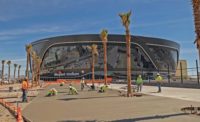Of the total of 900 sq m in this terminal, improvements comprise about 600 sq m. The part will connect to the new South Hall, also under construction. The site will have new check-in counters, baggage carousels, retail stores and eating areas.
"Terminal 2 will become the heart of the airport," says Silva.
New Digs
The structure of the new, 1-km-long South Hall, with 110,000 sq m of built area within three wings, is nearing completion.
Built with pillars, beams and 4,100 prefabricated slabs, the hall will have three floors and 26 arrival bridges, or “fingers.”
Workers will begin installing, in October, the hall's electronic systems, which require some 1,100 km of cables. Within the hall, there will be 14 moving walkways to facilitate passenger traffic.
In the vicinity of the hall is a 260,000-sq-m air pad, which will connect to the existing airfield. The earthwork required the moving of 2 million cu m of material.
The new yard required supplemental soil due to soft conditions. There, up to 11 m of excavation and backfill were processed. Disposal of soft soil was carried out nearby.
According to Silva, construction materials were staged inside a nearby industrial site and mine in order to prevent heavy trucks from blocking travelers’ access to the airport. "There are nearly a thousand trucks traveling here every day," he says.
Concession
In August 2014, the Riogaleão consortium—formed by Odebrecht Transport, Brazil, and Changi Airports International, Singapore—took over the management and operation of the airport in a 25-year concession.
By the end of the concession period, the concessionaire will have invested $1.3 billion in the airport, it says.




Post a comment to this article
Report Abusive Comment